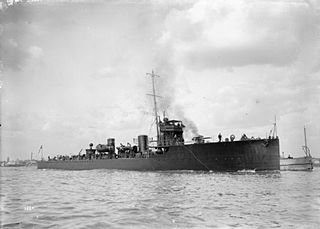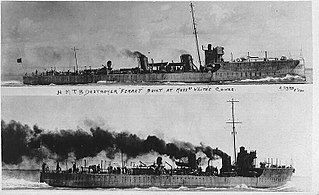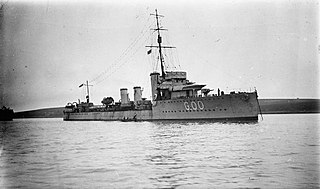
The Boadicea-class cruiser was a pair of scout cruisers built for the Royal Navy in the first decade of the 20th century. They were the first class of this type to be fitted with steam turbine machinery. Upon completion in 1909–10, the sister ships served as flotilla leaders for destroyer flotillas of the First Fleet until 1913 when they were assigned to battleship squadrons. When the First World War began in August 1914, they remained with their squadrons as the First Fleet was incorporated into the Grand Fleet, although they changed squadrons over the course of the war. Both ships were present during the Battle of Jutland in mid-1916, but neither fired a shot. They were converted into minelayers the following year and both ships laid minefields in early 1918 in addition to other missions. The sisters were reduced to reserve in 1919 and sold for scrap in 1921 and 1926.

HMS Vanoc was a British V-class destroyer, launched in 1917. The ship saw service in both the First and Second World Wars. During the First World War, Vanoc served as part of two destroyer flotillas, undertaking minelayer and convoy escort roles. In 1919, the destroyer took part in British operations in the Baltic as part of Allied efforts to intervene in the Russian Civil War. During the Second World War, Vanoc was involved in evacuation efforts to remove troops from Norway and France, and was utilised as a convoy escort, protecting convoys from German U-boats. In this role, Vanoc sank a German submarine, German submarine U-100 in March 1941 in the Atlantic, and assisted in the destruction of another, German submarine U-99. Three years later, Vanoc was involved in sinking U-392 in the Straits of Gibraltar in concert with a British frigate and several US anti-submarine aircraft. In January 1945, she was involved in a collision with another Allied vessel off Normandy, before being placed into reserve in June. She was later sold for scrap and was broken up after mid-1946.

HMS Ariel was an Acheron-class destroyer built in 1911, which served during the First World War and sank in 1918 after striking a mine. Named after Shakespeare's "airy spirit", or the biblical spirit of the same name, she was the tenth and last ship of the name to serve in the Royal Navy.

HMS Meteor was a Thornycroft M-class destroyer that served in the British Royal Navy. Meteor saw extensive service throughout World War I, maintaining continuous operations both as a convoy escort and in harbour protection.

HMS Ferret was an Acheron-class destroyer of the Royal Navy that served during World War I and was sold for breaking in 1921. She was the sixteenth Royal Navy ship to be named after the domestic mammal Mustela putorius.

HMS Vanquisher (D54) was a V-class destroyer of the British Royal Navy that saw service in World War I and World War II.

HMS Venturous (D87) was a V-class destroyer of the British Royal Navy that saw service in World War I.

The first HMS Vehement was a V-class destroyer of the British Royal Navy that saw service in World War I. She spent her short career in minelaying operations in the North Sea before striking a mine and sinking in 1918.

HMS Abdiel was a Marksman-class flotilla leader of the Royal Navy, built by Cammell Laird during the First World War. She was converted to a minelayer during construction, commissioning during 1916, and served at the Battle of Jutland. Following the end of the war, Abdiel served in the Baltic during the Russian Civil War. She was sold for scrap in 1936.
HMS Murray was a Royal Navy Admiralty M-class destroyer. Ordered before the outbreak of war, she was therefore the first of her class to enter operation during the early months of the First World War. She was also the first vessel of the Royal Navy to carry the name HMS Murray.

HMS Nimrod was a Marksman-class flotilla leader of the British Royal Navy. She was built by the Scottish shipbuilder Denny, with construction starting in 1914 and completed in August 1915. She served through the remainder of the First World War. She was sold for scrap in 1921.

HMS Kempenfelt was a Marksman-class flotilla leader of the British Royal Navy. She was built by the Cammell Laird at their Birkenhead shipyard, with construction starting in 1914 and completed in August 1915. She served through the remainder of the First World War. She was sold for scrap in 1921.

HMS Telemachus was a R-class destroyer of the British Royal Navy that took part in the First World War. She was built in 1916–1917 by the Scottish shipbuilder John Brown at their Clydebank shipyard. Telemachus was modified to serve as a minelayer, laying minefields in the German Bight and English Channel to restrict the operation of German submarines. The ship survived the war and was sold for scrap in 1927.
HMS Lark was a Laforey-class destroyer of the British Royal Navy. The Laforey class was the class of destroyers ordered under the Royal Navy's 1912–1913 construction programme, which were armed with three 4-inch (102 mm) guns and four torpedo tubes and were capable of 29 knots. The ship, which was originally to be named Haughty but was renamed before launch, was built by the Scottish shipbuilder Yarrow between 1912 and 1913.

HMS Princess Margaret was a minelayer operated by the British Royal Navy during and after the First World War. She was built by the Scottish shipbuilder William Denny for the Canadian Pacific Railway as a liner to serve on the Pacific West Coast, and as such was powered by geared steam turbines, giving a speed of 23 knots.

HMS Matchless was a Royal Navy Admiralty M-class destroyer. Matchless was built by Swan Hunter from 1913 to 1914 and was completed in December that year. She served through the remainder of the First World War, operating in the North Sea as part of the Harwich Force in the early part of the war and later in the English Channel as part of the Dover Patrol, where she took part in both the First and Second Ostend Raids. Despite being badly damaged by a German mine in 1915 and being involved in several collisions, she survived the war, and was sold for scrap in 1921.
HMS Milne was a Royal Navy Admiralty M-class destroyer. Milne was built by John Brown & Company from 1913 to 1914 and was completed in December that year. She served through the remainder of the First World War, at first with the Harwich Force with which she took part in the Battle of Dogger Bank in January 1915, and later with the Dover Patrol, sinking the German submarine UC-26 in May 1917. Milne was sold for scrap in 1921.
HMS Gabriel was a Marksman-class flotilla leader of the British Royal Navy, that took part in the First World War. The ship was built by Cammell Laird at Birkenhead, being launched on 23 December 1915 and entering service in July 1916. Gabriel served with the Grand Fleet, leading a destroyer flotilla and was later used as a minelayer. She survived the war, before being sold for scrap on in May 1921.

HMS Seymour was a Parker-class flotilla leader of the British Royal Navy. She was built by Cammell Laird during the First World War, being launched on 31 August 1916 and completing on 30 November that year. Seymour served with the Grand Fleet for the rest of the war, which she survived. The ship was sold for scrap in January 1931.
HMS Grasshopper was a Beagle-class destroyer of the British Royal Navy. The Beagles were coal-fuelled ships, designed for a speed of 27 kn, armed with a 4-inch (102 mm gun and two torpedo tubes. Grasshopper was built by Fairfield Shipbuilding & Engineering Company at their Govan yard, between 1909 and 1910, being launched on 23 November 1909 and completing in July 1910.















